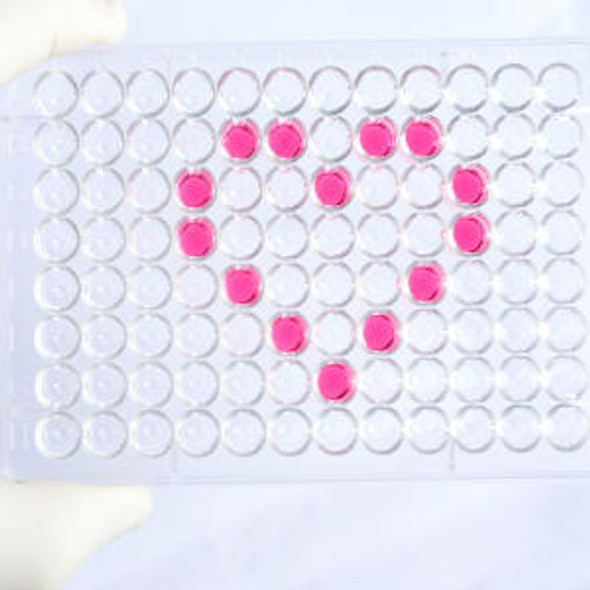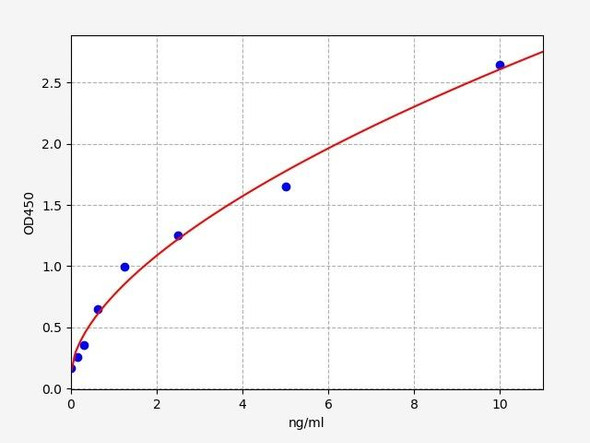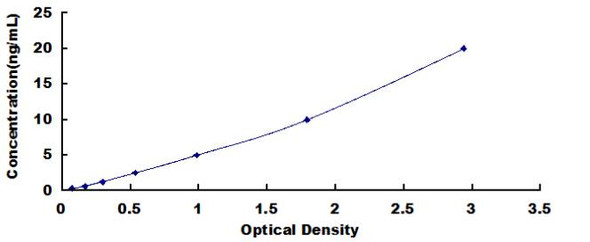Human Heat shock factor protein 4 (HSF4) ELISA Kit (HUEB2597)
- SKU:
- HUEB2597
- Product Type:
- ELISA Kit
- Size:
- 96 Assays
- Uniprot:
- Q9ULV5
- Range:
- 0.156-10 ng/mL
- ELISA Type:
- Sandwich
- Synonyms:
- HSF4, ATHSF4, AT-HSFB1, CTM, HSFB1, cataract, Marner, heat shock factor protein 4, heat shock transcription factor 4CTM, hHSF4, HSF 4, HSTF 4
- Reactivity:
- Human
Description
Human Heat shock factor protein 4 (HSF4) ELISA Kit
The Human Heat Shock Factor Protein 4 (HSF4) ELISA Kit is a powerful tool for the precise measurement of HSF4 levels in human samples, including serum, plasma, and cell culture supernatants. This innovative kit offers exceptional sensitivity and specificity, guaranteeing accurate and consistent results for a variety of research applications.HSF4 is a key regulator of cellular stress response, playing a vital role in protecting cells from damage caused by environmental stressors. Dysregulation of HSF4 has been linked to various diseases, including neurodegenerative disorders, cardiovascular conditions, and cancer.
By accurately measuring HSF4 levels, researchers can gain valuable insights into the mechanisms underlying these diseases and explore potential therapeutic targets.With its unparalleled performance and versatility, the Human Heat Shock Factor Protein 4 (HSF4) ELISA Kit is an indispensable tool for studying cellular stress responses and investigating the pathophysiology of complex diseases. Trust in this kit to deliver reliable and reproducible results, advancing your research efforts in the field of molecular biology and beyond.
| Product Name: | Human Heat shock factor protein 4 (HSF4) ELISA Kit |
| SKU: | HUEB2597 |
| Size: | 96T |
| Target: | Human Heat shock factor protein 4 (HSF4) |
| Synonyms: | Heat shock transcription factor 4, HSTF 4, HSF 4 |
| Assay Type: | Sandwich |
| Detection Method: | ELISA |
| Reactivity: | Human |
| Detection Range: | 0.156-10ng/mL |
| Sensitivity: | 0.076ng/mL |
| Intra CV: | 6.1% | ||||||||||||||||||||
| Inter CV: | 9.8% | ||||||||||||||||||||
| Linearity: |
| ||||||||||||||||||||
| Recovery: |
| ||||||||||||||||||||
| Function: | DNA-binding protein that specifically binds heat shock promoter elements (HSE). Isoform HSF4A represses transcription while the isoform HSF4B activates transcription. |
| Uniprot: | Q9ULV5 |
| Sample Type: | Serum, plasma, tissue homogenates, cell culture supernates and other biological fluids |
| Specificity: | Natural and recombinant human Heat shock factor protein 4 |
| Sub Unit: | Homotrimer. Exhibits constitutive DNA binding and forms trimers even in the absence of stress. Interacts with ALKBH4, DUSP26, MAPK1, MAPK2 and MAP kinase p38. |
| Subcellular Location: | Nucleus |
| Storage: | Please see kit components below for exact storage details |
| Note: | For research use only |
| UniProt Protein Function: | HSF4: DNA-binding protein that specifically binds heat shock promoter elements (HSE). Isoform HSF4A represses transcription while the isoform HSF4B activates transcription. Defects in HSF4 are the cause of cataract, zonular (CZ). A form of zonular cataract. Zonular or lamellar cataracts are opacities, broad or narrow, usually consisting of powdery white dots affecting only certain layers or zones between the cortex and nucleus of an otherwise clear lens. The opacity may be so dense as to render the entire central region of the lens completely opaque, or so translucent that vision is hardly if at all impeded. Zonular cataracts generally do not involve the embryonic nucleus, though sometimes they involve the fetal nucleus. Usually sharply separated from a clear cortex outside them, they may have projections from their outer edges known as riders or spokes. Defects in HSF4 are the cause of cataract Marner type (CAM). A form of cataract with variable and progressive opacities. Affected individuals present with zonular cataract, although some have nuclear, anterior polar, or stellate cataract. Finger malformation is observed in some kindreds. Belongs to the HSF family. 2 isoforms of the human protein are produced by alternative splicing. |
| UniProt Protein Details: | Protein type:Transcription, coactivator/corepressor; Cell development/differentiation; DNA-binding Chromosomal Location of Human Ortholog: 16q21 Cellular Component: nucleoplasm Molecular Function:transcription corepressor activity Biological Process: regulation of transcription, DNA-dependent Disease: Cataract 5, Multiple Types |
| NCBI Summary: | Heat-shock transcription factors (HSFs) activate heat-shock response genes under conditions of heat or other stresses. HSF4 lacks the carboxyl-terminal hydrophobic repeat which is shared among all vertebrate HSFs and has been suggested to be involved in the negative regulation of DNA binding activity. Two alternatively spliced transcripts encoding distinct isoforms and possessing different transcriptional activity have been described. [provided by RefSeq, Jul 2008] |
| UniProt Code: | Q9ULV5 |
| NCBI GenInfo Identifier: | 296434534 |
| NCBI Gene ID: | 3299 |
| NCBI Accession: | Q9ULV5.2 |
| UniProt Secondary Accession: | Q9ULV5,Q99472, Q9ULV6, |
| UniProt Related Accession: | Q9ULV5 |
| Molecular Weight: | 49,952 Da |
| NCBI Full Name: | Heat shock factor protein 4 |
| NCBI Synonym Full Names: | heat shock transcription factor 4 |
| NCBI Official Symbol: | HSF4 |
| NCBI Official Synonym Symbols: | CTM; CTRCT5 |
| NCBI Protein Information: | heat shock factor protein 4 |
| UniProt Protein Name: | Heat shock factor protein 4 |
| UniProt Synonym Protein Names: | Heat shock transcription factor 4; HSTF 4 |
| Protein Family: | Heat shock factor protein |
| UniProt Gene Name: | HSF4 |
| UniProt Entry Name: | HSF4_HUMAN |
| Component | Quantity (96 Assays) | Storage |
| ELISA Microplate (Dismountable) | 8×12 strips | -20°C |
| Lyophilized Standard | 2 | -20°C |
| Sample Diluent | 20ml | -20°C |
| Assay Diluent A | 10mL | -20°C |
| Assay Diluent B | 10mL | -20°C |
| Detection Reagent A | 120µL | -20°C |
| Detection Reagent B | 120µL | -20°C |
| Wash Buffer | 30mL | 4°C |
| Substrate | 10mL | 4°C |
| Stop Solution | 10mL | 4°C |
| Plate Sealer | 5 | - |
Other materials and equipment required:
- Microplate reader with 450 nm wavelength filter
- Multichannel Pipette, Pipette, microcentrifuge tubes and disposable pipette tips
- Incubator
- Deionized or distilled water
- Absorbent paper
- Buffer resevoir
*Note: The below protocol is a sample protocol. Protocols are specific to each batch/lot. For the correct instructions please follow the protocol included in your kit.
Allow all reagents to reach room temperature (Please do not dissolve the reagents at 37°C directly). All the reagents should be mixed thoroughly by gently swirling before pipetting. Avoid foaming. Keep appropriate numbers of strips for 1 experiment and remove extra strips from microtiter plate. Removed strips should be resealed and stored at -20°C until the kits expiry date. Prepare all reagents, working standards and samples as directed in the previous sections. Please predict the concentration before assaying. If values for these are not within the range of the standard curve, users must determine the optimal sample dilutions for their experiments. We recommend running all samples in duplicate.
| Step | |
| 1. | Add Sample: Add 100µL of Standard, Blank, or Sample per well. The blank well is added with Sample diluent. Solutions are added to the bottom of micro ELISA plate well, avoid inside wall touching and foaming as possible. Mix it gently. Cover the plate with sealer we provided. Incubate for 120 minutes at 37°C. |
| 2. | Remove the liquid from each well, don't wash. Add 100µL of Detection Reagent A working solution to each well. Cover with the Plate sealer. Gently tap the plate to ensure thorough mixing. Incubate for 1 hour at 37°C. Note: if Detection Reagent A appears cloudy warm to room temperature until solution is uniform. |
| 3. | Aspirate each well and wash, repeating the process three times. Wash by filling each well with Wash Buffer (approximately 400µL) (a squirt bottle, multi-channel pipette,manifold dispenser or automated washer are needed). Complete removal of liquid at each step is essential. After the last wash, completely remove remaining Wash Buffer by aspirating or decanting. Invert the plate and pat it against thick clean absorbent paper. |
| 4. | Add 100µL of Detection Reagent B working solution to each well. Cover with the Plate sealer. Incubate for 60 minutes at 37°C. |
| 5. | Repeat the wash process for five times as conducted in step 3. |
| 6. | Add 90µL of Substrate Solution to each well. Cover with a new Plate sealer and incubate for 10-20 minutes at 37°C. Protect the plate from light. The reaction time can be shortened or extended according to the actual color change, but this should not exceed more than 30 minutes. When apparent gradient appears in standard wells, user should terminatethe reaction. |
| 7. | Add 50µL of Stop Solution to each well. If color change does not appear uniform, gently tap the plate to ensure thorough mixing. |
| 8. | Determine the optical density (OD value) of each well at once, using a micro-plate reader set to 450 nm. User should open the micro-plate reader in advance, preheat the instrument, and set the testing parameters. |
| 9. | After experiment, store all reagents according to the specified storage temperature respectively until their expiry. |
When carrying out an ELISA assay it is important to prepare your samples in order to achieve the best possible results. Below we have a list of procedures for the preparation of samples for different sample types.
| Sample Type | Protocol |
| Serum | If using serum separator tubes, allow samples to clot for 30 minutes at room temperature. Centrifuge for 10 minutes at 1,000x g. Collect the serum fraction and assay promptly or aliquot and store the samples at -80°C. Avoid multiple freeze-thaw cycles. If serum separator tubes are not being used, allow samples to clot overnight at 2-8°C. Centrifuge for 10 minutes at 1,000x g. Remove serum and assay promptly or aliquot and store the samples at -80°C. Avoid multiple freeze-thaw cycles. |
| Plasma | Collect plasma using EDTA or heparin as an anticoagulant. Centrifuge samples at 4°C for 15 mins at 1000 × g within 30 mins of collection. Collect the plasma fraction and assay promptly or aliquot and store the samples at -80°C. Avoid multiple freeze-thaw cycles. Note: Over haemolysed samples are not suitable for use with this kit. |
| Urine & Cerebrospinal Fluid | Collect the urine (mid-stream) in a sterile container, centrifuge for 20 mins at 2000-3000 rpm. Remove supernatant and assay immediately. If any precipitation is detected, repeat the centrifugation step. A similar protocol can be used for cerebrospinal fluid. |
| Cell culture supernatant | Collect the cell culture media by pipette, followed by centrifugation at 4°C for 20 mins at 1500 rpm. Collect the clear supernatant and assay immediately. |
| Cell lysates | Solubilize cells in lysis buffer and allow to sit on ice for 30 minutes. Centrifuge tubes at 14,000 x g for 5 minutes to remove insoluble material. Aliquot the supernatant into a new tube and discard the remaining whole cell extract. Quantify total protein concentration using a total protein assay. Assay immediately or aliquot and store at ≤ -20 °C. |
| Tissue homogenates | The preparation of tissue homogenates will vary depending upon tissue type. Rinse tissue with 1X PBS to remove excess blood & homogenize in 20ml of 1X PBS (including protease inhibitors) and store overnight at ≤ -20°C. Two freeze-thaw cycles are required to break the cell membranes. To further disrupt the cell membranes you can sonicate the samples. Centrifuge homogenates for 5 mins at 5000xg. Remove the supernatant and assay immediately or aliquot and store at -20°C or -80°C. |
| Tissue lysates | Rinse tissue with PBS, cut into 1-2 mm pieces, and homogenize with a tissue homogenizer in PBS. Add an equal volume of RIPA buffer containing protease inhibitors and lyse tissues at room temperature for 30 minutes with gentle agitation. Centrifuge to remove debris. Quantify total protein concentration using a total protein assay. Assay immediately or aliquot and store at ≤ -20 °C. |
| Breast Milk | Collect milk samples and centrifuge at 10,000 x g for 60 min at 4°C. Aliquot the supernatant and assay. For long term use, store samples at -80°C. Minimize freeze/thaw cycles. |
| ELISA |
| Human HSF4 ELISA Kit |










